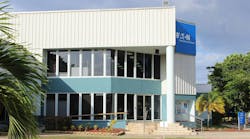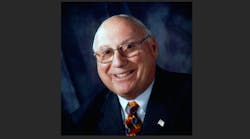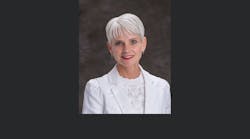DOE Workshop in Chicago showcases LED lighting's potential and problems
Along with offering a status check on the adoption of LED lighting systems, the Department of Energy's three-day Solid-State Lighting Market Introduction Workshop provided more than 250 lighting professionals with a three-day immersion into the practical application, science and art of LED lighting systems. Held July 13-15 in Chicago, the conference agenda touched upon a wide range of topics of critical importance to a segment of the lighting market that has captured the imagination of lighting professionals. Included on the agenda at the workshops were panel discussions on LED lighting standards, marketing, reliability, design and cost effectiveness.
The diverse backgrounds of the panel participants reflected just how broadly the LED movement has already touched not only the lighting industry but municipalities, Fortune 500 companies, small businesses and utilities. For instance, executives from Home Depot and Grainger talked about their early experiences in selling LEDs; representatives from the cities of Oakland and San Marcos, Calif., and Anchorage, Alaska, presented case studies on their LED street lighting retrofits; a senior executive from Wal-Mart spoke about a successful parking lot implementation of LEDs at a store prototype in Leavenworth, Kan., and a lighting designer from Arkansas gave attendees a glimpse of a LED retrofit of a McDonald's in Cary, N.C.
While LEDs are not yet cost-effective solutions for general-purpose lighting such as office lighting or most residential applications, panelists offered plenty of examples of how LEDs can offer attractive returns on investment and superior lighting quality when compared to traditional lighting systems. Cove lighting systems, freezer lighting and parkway and roadway lighting were mentioned most frequently at the workshop as being prime applications for today's generation of LED lighting, but panelists and attendees agreed that it's just a matter of time — by some estimates only three to five years — before LED technology becomes cost-effective for more general-purpose lighting applications.
James Brodrick, who manages the DOE's solid-state lighting effort and has quickly become one of the leaders in the LED movement, was emcee for the event. He has helped the DOE become a central player in the LED industry by collaborating with manufacturers, allied trade associations, electric utilities and stakeholders in the lighting standards process such as the Illuminating Engineering Society of North America and the National Electrical Manufacturers Association (NEMA), Rosslyn, Va. Key to the DOE's efforts in championing LED and solid-state lighting have been its efforts in promoting a bevy of stringent performance criteria including the LM-79-08 lighting standard and the EnergyStar program; the CALiPER testing program that provides independent testing of new LED products; the LightingFacts product labeling program; the Next Generation Lighting (NGL) Luminaires design competition; the L-Prize competition for the design of replacements for 60W incandescent and PAR 38 lamps; the DOE Gateway program that showcases LED lighting systems in commercial and residential applications; federal funding for LED research; and robust educational efforts available online and through semi-annual workshops.
A big part of DOE's efforts in helping to introduce LEDs to the mainstream lighting market is to not repeat the mistakes that the lighting industry made in introducing compact fluorescent lamps in the late 1980s. Brodrick and other speakers at the DOE LED workshop said many of the early CFLs that hit the market had poor light quality, were not dimmable and were unreliable. These stumbling blocks delayed the general acceptance of CFLs for years, and Brodrick does not want LED manufacturers to make the same mistake. “The last thing we want is for bad products to get out there and put us several years behind the market adoption process,” he said. “CFLs lost at least a decade in getting to the market. We are studying what went wrong.”
LED proponents don't want to repeat the mistakes made with CFLs, and several of the panelists weren't afraid to bash CFLs as an ineffective lighting technology with dangerous environmental side effects because of the small amounts of mercury each lamp contains. That being said, LEDs will have their own challenges before they become widely accepted. Brodrick and other panelists acknowledged the amount of bogus product performance claims in the market put out by some vendors new to the LED industry and the fact that many manufacturers' LEDs — in some cases more than 50 percent — did not pass the DOE's rigorous CALiPER testing program. What's equally disconcerting about the test results is that these are only the products actually submitted for testing, and many LED vendors have not yet submitted their products.
Several key takeaways from the conference included the importance of looking at all the components in a LED lighting system (including the driver, heat sink, optics and light fixture) and not just focusing on the LED itself, and the importance of measuring the total amount of light produced by a LED luminaire in an actual application and not relying on manufacturers' test data because of the impact of lumen depreciation, heat, vibration, mounting height and many other specific application parameters.
Avraham Mor, a lighting designer with LightSwitch Architectural, a Chicago-based lighting design firm, offered a real-world perspective on LED progress, as his firm designed the LED lighting system for the Wit, a Doubletree Hotel that just opened in Chicago on July 15. Mor said lighting professionals must realize that in any LED installation they may run into challenges in meeting electrical code requirements, supply issues with electrical distributors and lighting reps selling the LED product lines, and training issues with electrical contractors who are not yet familiar with LED technology.
DOE Testing for LEDs offers some surprises
The CALiPER test results for LED lighting products recently published by the Department of Energy (DOE) were discussed thoroughly at the DOE workshop. The tests provide an interesting status check of the state of the fledgling solid-state lighting industry. Some LEDs in the DOE Energy Efficiency & Renewable Energy program's CALiPER tests outperformed existing light sources like compact fluorescents and incandescent PAR lamps, while an amazing 50 percent didn't even meet their manufacturers' published marketing claims. The fact that the lighting industry needs a performance testing program like its CALiPER testing standards says something about some of the history of product development in the lighting industry.
Burned by poor performance of some compact fluorescent lamps (CFLs) and electronic ballasts when they were introduced approximately 15 to 20 years ago, responsible lighting manufacturers want to make sure the first wave of LED products don't turn off potential customers with poor performance, and are having their products tested under the tough DOE CALiPER testing standards as well as the additional EnergyStar standards.
The CALiPER report said some of the solid-state lighting sources tested in Round 8 — which included replacement lamps, downlights, track lighting, undercabinet fixtures and outdoor fixtures — are “now approaching, matching, and sometimes exceeding the light output levels, distribution, and color quality of similar lamps and luminaires that use traditional sources such as incandescent, halogen, and CFLs. Unfortunately, more than half of the products tested in this round have inaccurate or misleading product literature. Most severely, equivalency claims in product literature for replacement lamps are almost always false and misleading.”
This round of CALiPER testing was particularly interesting because some of the lamps tested are designed to be direct replacements for MR16, PAR and “R” lamps, some of the more common lamps used in the commercial and residential markets. Said the CALiPER report, “Taken as a whole, a wide range of performance is observed among these SSL replacement lamps, with some clearly representing viable replacements for incandescent, halogen or CFLs, and some performing clearly far below manufacturer claims. In general, they perform quite well with respect to efficacy, color quality and intensity, but not necessarily so well with respect to total light output, power factors and accuracy of product ratings.”
It was also interesting to note the manufacturers that scored high in this round of testing. Some, like Juno Lighting and Cree and are well-known in the mainstream lighting market; others like Marktech and Lighting Science Group are not yet household names in the lighting business.
An issue related to the performance claims of some manufacturers is the environment in which they test their products. Seminar panelists at the DOE's Solid-State Lighting Workshop said some manufacturers make the mistake of not testing their LED lamps in the types of fixtures in which they will be used. Heat buildup in some lighting fixtures not designed for use with LEDs can dramatically shorten the life of the LED light source.
These test results also reflect the fact that LED technology is improving month-by-month and that many if not most of the best-known names in the lighting business are doing their best to develop quality lighting products. But the test results also touch upon the fact that product quality is a huge issue in the LED market and that some new players are rushing into the business with no track record in the market, get-rich quick schemes and little concern for the long-term viability of the products they are now marketing.
Analyzing all of these changes is Jim Brodrick, the DOE's Solid-State Lighting Program manager. His popular e-mail newsletter, “Postings from Jim Brodrick,” has quickly become a must-read for lighting professionals who want to keep up with the pace of R&D in the solid-state lighting market. In his most recent posting Brodrick said that overall, Round 8 of the CALiPER testing confirmed the continuous upward trend in performance since DOE began the testing program in 2006. But it will take time before LEDs can compete with all conventional light sources.
“Last fall, CALiPER benchmark tested conventional and SSL MR16 lamps from the buyer perspective,” he wrote. “We found wide variations in performance, and the CALiPER MR16 Benchmark Report published in November 2008 concluded that then current MR16s did not meet 20W halogen levels, much less 35W or 50W halogen lamps. Now, just eight months later, the results for SSL MR16 lamps tested in Round 8 are quite encouraging. With respect to color, all have CRI over 70, with the best at 93. All have warm white or neutral white CCT levels, which is fairly similar to the most common halogen replacement lamps. And as for total light output, one of the warm-white SSL MR16 lamps clearly meets and exceeds what a buyer would expect of a 20W halogen MR16 lamp, and delivers over three times the average efficacy of halogens.”
Brodrick also said some LED replacements for common varieties of floodlights such as PAR20, PAR30 and PAR38 can meet “light output levels and beam characteristics of 35W to 50W incandescent and halogen lamps, with efficacy levels similar to lower wattage CFL products.”
Regarding the accuracy of suppliers' performance claims, Brodrick said, “Equivalency claims are often solely for the replacement lamp and not for the actual measured performance when integrated into a luminaire. This reflects the learning curve many product integrators face as they begin to better understand how to measure, report and assess LED products.”
One LED manufacturer that exemplifies that potential and challenges that confront LED manufacturers is C.C. Crane Co. Inc., Fortuna, Calif., which markets the GeoBulb as a direct replacement for 60W screw-in incandescent at www.ccrane.com. Priced at $99.95, the bulb is quite expensive, particularly when one considers that a 60W incandescent can be purchased at home centers for less than one dollar.
The GeoBulb also had mixed results in the recent CALiPER tests. It did very well on the tests' Color Rendering Index (CRI) (a measure of lighting quality) with a score of 80. But its test result for lumens (a measure of how much light reached the intended area or subject to be lit) and lumens per watt (how many lumens are produced compared to how much energy is consumed) were measured by DOE as being below its published claims.
Ledtronics Takes Issue with EW's July Cover Story on LEDs
Editor's note
Electrical Wholesaling magazine welcomes a dialog with its readers and is glad to run “Letters to the Editor.” Send them to Jim Lucy, chief editor, at [email protected]. Following is an e-mail we recently received from Jordon Papanier, marketing manager, LEDTronics, Torrance, Calif. He took issue with how he believed the article portrayed 5mm LEDs.
The 5mm type white LEDs have gotten a bad rap for some very good and also for many more very bad reasons. The good reasons that they should be rejected are due to their obvious misuse in some applications, as pointed out in the article (Electrical Wholesaling, July 2009, “The Profits and Perils of LEDs,” page 20).The greater issues have to do with the poor quality of the less costly 5mm LEDs manufactured with iron-based lead frame material, which are used in many cheap white LED products that have come onto the market, and also the fact that these LED products are often overdriven in their cheaply engineered packages. On the other hand, to back up our engineering efforts over the past 25-plus years as well as providing good thermal management LEDtronics offers three-to-five-year product warranties, including for the 5mm LED products. There are a lot of fly-by-night companies who have emerged onto the LED manufacturing landscape who have very little expectance on the fundamentals of how an LED works in a cluster packaged in a bulb. Almost all of the comments in the article seem somewhat biased to me, or just plain misinformed, as the issue of ‘proper’ use of well engineered 5mm LEDs is never mentioned. It is as though there is no way in these people's' minds to correctly manufacture 5mm LEDs and then utilize these low-power LEDs in properly packaged general lighting products.
To the contrary, utilization of long-life LED lead frame material within the 5mm LEDs, in conjunction with driving the 5mm LEDs current levels correctly, will allow for some maximum sustainability. I don't think that the solid-state lighting industry should be misrepresented in this fashion by those less experienced in LED product packaging than LEDtronics, in a seeming attempt to “throw out the baby with the bath water.”Here is a typical misrepresentation from the article. “Low-powered LEDs have their place, like in accent lighting. They are not good for general lighting. Some LED manufacturers take about 20 low-power LEDs and a PAR 30 or PAR 38 bulb, take out the insides of the bulb and then put an electronic circuit board down inside of it and hook these LEDs into it. It's just a whole bunch of LEDs stuffed into an envelope that looks like a lamp. They are going to degrade over time.”
LEDtronics take on this. The R30 type 5mm LED bulb that we manufacture has over 100 LEDs per bulb package and the PAR38 package we offer contains almost 200 LEDs per bulb package, so that fact puts the above comment in perspective, although it is of course understood that the cheap LED junk at Wal-Mart and elsewhere uses too few LEDs and overdrives them. Conversely, with LEDtronics product efforts. For example, the new 27W -TPW type acorn lamp is driven correctly with its hundreds of 5mm LEDs and still performs with the new 5000K technology at about 90 lumens per watt, and has a five-year warranty to boot! LEDtronics has been designing 5mm LED bulbs for more than 25 years now. Our 5mm LED bulb does not suffer from the poor quality designs that your article called out. If you do not know what you are doing you can have the same short life LED light with the high power 1W, 2W or 5W LED bulbs as well. If you need more LED information or are writing any future articles on LED or LED bulbs please feel free to contact me for our input.
(I am) not sure where your contacts are getting their 5mm LED bulbs from, but they are obviously not going to a well-established LED bulb manufacturer. All I can point out is that LEDtronics has been designing 5mm LED bulbs for more than 25 years and we do not have any of the issues that this article called out. The Department of Energy has tested a few of our 5mm LED bulbs and we received some favorable test reports from them. The owner and founder of LEDtronics, Pervaiz Lodhie, started designing 5mm LED bulbs over 25 years ago and understands the property of most if not all the 5mm and the newer high-power LEDs on the market. Your statement that some rogue companies are looking to make a quick buck with inferior products and false marketing claims is very true. Like with anything, you get what you pay for. We just want to make sure your readers and your contacts understand that there are a few high-quality LED bulb manufactures who know how to design and build high quality 5mm LED bulbs.
The so-called lighting professionals suffer from the same short sightedness that all contractors fall under that is the bottom line. They buy the low-cost solution then wonder why they do not get the results they wanted.
— Jordon P. Papanier, Marketing Manager, LEDtronics, Inc.
Electrical Wholesaling's response
EW's editors take issue with Mr. Papanier's comment that “almost all of the comments in the article seem somewhat biased to me, or just plain misinformed, as the issue of ‘proper’ use of well engineered 5mm LEDs is never mentioned.” The sources contacted in this article were lighting professionals with decades of experience. If that's their take on low-powered LEDs, then so be it — that's how EW will report it. We didn't go into the reporting of this article with any preconceived notions of the advantages or disadvantages of any particular type of LED. As any reader can see by the number of people contacted for and identified in the article, the research into this topic was extensive. And as a side note, Jim Lucy attended a three-day seminar on LEDs that was run by the Department of Energy and the treatment of the potential problems with some low-powered LED lamps was right in line with the sentiment of the conference, which was attended by more than 250 lighting professionals.








